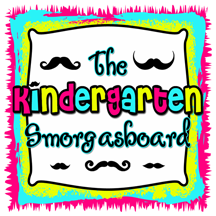I am also going to be making myself a laminated file folder come August. I absolutely must have one to ad to my repertoire of anchor charts. I like to mix it up throughout the year so that students don't become bored. I use Venn Diagrams, Tony Stead's RAN chart (similar to KWL - but I like it better), Can/Have/Are charts, Story Element Charts, and Alpha Boxes.
I earned my Masters in Literacy in 2013. I learned so much. The professor of my Multicultural class, a wonderful lady named Barb Mallinger, taught us a new way to do Venn Diagrams which helps both ELL and struggling students organize their thinking. Instead of circles, which inevitably are too small in the middle, she recommends using squares so that the middle can be of equal size to the outer sections. She also suggested that when first doing this, provide students with some beginning topics to think about. This made such a difference for my Kinders who struggled with language. It really helped their thinking hone in to particular parts of the story.
The bat above me is an example of Tony Stead's RAN chart or Reading Analysis of Nonfiction. It is similar to a KQL, but I find it more user friendly for Kinders. The first section is "What We Think We Know." My students either draw or write what they think they know - in this case - about bats. The second column is "Yes, I Was Right!" This is my favorite part. After doing the first column, I read nonfiction books about the topic. The students then have to look and listen for their thought to be proven true through either the illustrations or the text. This part really keeps the kids in tune. If their thought is proven true, they get to come up and move their post-it over to the second column. The third column is "New Things We Learned." After reading Chapter 5, I want to bring in some of Debbie's concepts. Next time I do this chart, I want to put the new learning on another color post-it so that we can connect our thinking. So excited to try this! The last section is for questions we have as we learn about that topic. If a student has a thought that is never proven true, their post-it stays in the
first column. As we read we discuss why that thinking was not accurate. And because I teach Kinder, I sometimes allow that student to revise their thinking on a new post-it - but the first post-it still stays in the first column.
The graphics and headings of this Can/Have/Are chart are from Deanna Jump's Spider Unit. I again want to bring in Debbie Miller's concept of connecting our thinking so will again use a new color post-it the next time I do this.
I LOVE reading several versions of traditional folktales to compare and contrast story elements. One of my favorite to do this with is the Three Little Pigs. There are so many fun versions out there that have some unique twists, characters, or settings. I chose not to do problem and solution in this particular chart as that was not my focus.
Alpha Boxes are another thing I learned about in my Masters program. I thought they may be too hard for Kinders, but actually do great when used with the whole group. I always tell my students that we will NOT have something in every box and that is okay. As you read non-fiction texts about a topic, in this case owls, you add the students' thin kings to the letter that it corresponds with. I like to draw a quick picture next to as well just to make the learning more visual. You can also use different colors each day as a way for students to see the volume of what they have learned.
In my Chapter 4 post I talked about wanting to write down the question prompts that Debbie Miller uses. I am also going to jot down some notes for myself to use as I model making my thinking visible and phrases which will help students connect their thinking and create mental files of all their learning.
Be sure to check out the posts for this Chapters Hostess and the post from the coordinator The Kindergarten Smorgasboard.









I loved all the charts you included in your post, especially the AlphaBoxes. That is such a great way to approach a topic. I will definitely be trying that with my kiddos next year.
ReplyDelete